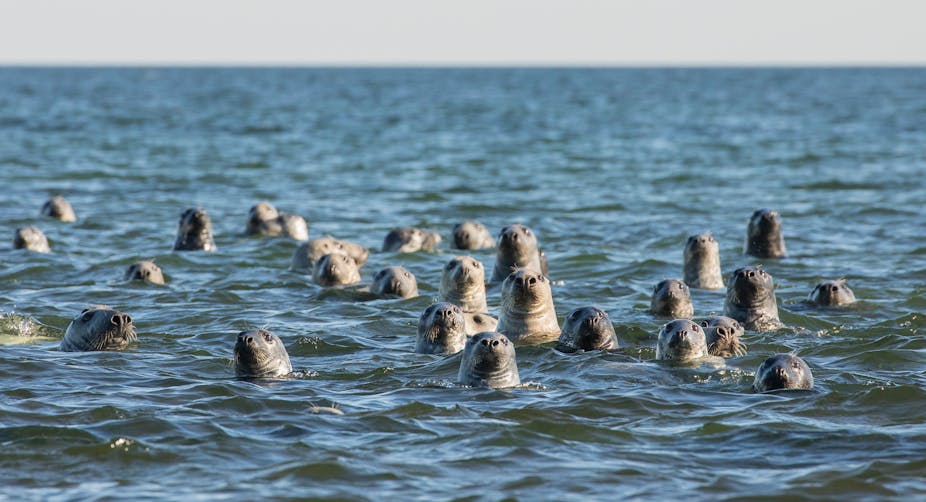Seals, sea lions and walruses – a group of animals called pinnipeds – have been heavily exploited throughout much of human history. Many of these species have at some point even been threatened with extinction.
But, in the UK, their decline has largely been reversed. Since the Conservation of Seals Act 1970 prohibited the killing or injuring of grey and harbour seals around the UK, the number of grey seals in the country has doubled to 157,000 – although there seems to be significant regional variation. More than one-third of the world’s grey seals now populate the UK’s waters.
This is excellent news for seal conservation. But it can be problematic for the fishing industry, which now faces an increase in damage to catch and gear inflicted by seals. Understanding how seal populations are changing will help manage their interactions with fisheries and other marine industries.
Grey seals and other pinnipeds are intelligent and highly adaptable creatures, able to switch their prey and foraging habits to suit their environment. But the threats these species face are changing fast. Slow to reproduce and vulnerable to climate change and disease, these now common animals could become threatened in the future should conditions continue to change.

Opportunistic foragers
The population expansion of UK grey seals is probably the result of several factors.
In the decade that followed the Conservation of Seals Act, rising populations may have been the result of a lack of hunting or managed culls. Culls were carried out at some grey seal sites in the 1970s, but not as blanket attempts to control the overall population.
But since then, population increases may instead be due to changes in food availability. In the absence of other sources of mortality, food availability often drives population expansion. And grey seals are opportunistic foragers that feed on whichever prey is easiest to catch.
Several studies have looked at how grey seal diets have changed over the past few decades. By examining the hard parts that remain in seal faeces such as bones and shells, it is possible to reconstruct their prey. This technique underreports some food groups such as salmonids, but is currently the only method that allows scientists to quantify a seal’s diet.
In three separate years (1985, 2002 and 2010), seal faeces were collected in coastal areas of Scotland and eastern England. Seal diets consisted of 66 different species, showcasing their ability to exploit whatever prey becomes available.
When large fish are absent, they hunt smaller prey such as sandeels. But, as populations of larger prey species such as herring, cod and whiting increase, they exploit this too.
No time for complacency
Grey seals, and other pinnipeds, inhabit a dynamic environment and the threats they face are changing rapidly. Climate change, for example, is affecting local food composition and abundance.
One of the main ways this occurs is through a process called “tropicalisation”, where rising sea temperatures cause warm water species to replace species that live in cooler waters. On average, marine species are shifting polewards at a rate of 72km per decade.
Seals are also vulnerable to population shocks. Pinnipeds have a long lifespan and tend to have small numbers of offspring – usually only one pup per year. Any environmental change that is short-lived can be buffered by seals’ longevity. If they don’t successfully pup one year, then they are likely to do so the next.
But any increase in adult mortality can quickly affect a population. Seal populations are therefore particularly vulnerable to diseases and other sources of adult mortality.
Respiratory diseases have a particularly acute impact on the foraging ability of diving animals such as seals. What could be a relatively minor threat to an animal that lives on land, could be life-threatening to one that dives. For example, more than 3,000 sea lions were found dead or dying on Peru’s coast following an outbreak of influenza in January 2023. Over 1,000 sea lions died on just one island, Isla San Gallan.
Climate change is likely to increase the risk of disease in the future. Research finds that warmer conditions favour pathogen development, survival and spread.
Green energy infrastructure
The way that humans use the sea is also changing. Offshore wind, for example, is projected to supply around one-third of the UK’s electricity generation by 2030. But, the construction, operation and maintenance of offshore wind farms causes noise disturbance and may change the behaviour of marine animals.
Research on harbour seals found that they tend to avoid areas where piling activity (the process of driving foundations into the seabed) is ongoing. Where piling is occurring, seals use of the area was found to decrease by 83%.
But offshore wind infrastructure can also lead to the development of artificial reefs. These reefs may result in an increased density of prey in the surrounding area and could improve foraging opportunities. Whether ocean infrastructure such as this will benefit seals depends on if it supports an increase in prey populations across a region – or simply concentrates existing populations in a smaller area.

Grey seals are the top marine predator in UK waters and seem to have become more common since the 1980s. But their situation remains precarious and they have little buffer should conditions change. This vulnerability highlights the importance of understanding the impact of future threats including climate change, more renewable energy infrastructure and disease outbreak.

